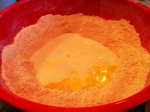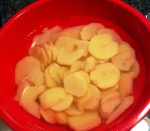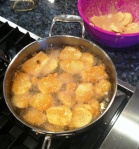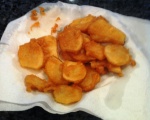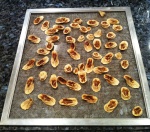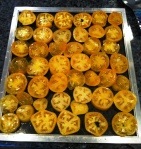A couple of years ago for St. Patrick’s Day, I wanted to make a traditional Irish meal. Along with the Irish Stew, I had to have Irish Soda Bread. A classic pairing. I searched around the internet for some ideas and recipes and was amazed at how easy and quick making this “bread” really was. In addition, the flavors in the bread are wonderful as is the dense texture. We have made it many times since, and often toasted in the morning with a slice of Irish Butter.
Try this recipe and see what you think. To show you how easy it is I have included 15 pix taken by my granddaughter, Katherine A. Lien, who is now my official Blog videographer. My first shot at one of these “how to” posts, so let me know if it is at all helpful.
First, assemble all your ingredients and tools. Not much is required, and as you can see from pix #1 it all fits in one photograph!!!.
Next, in a large bowl mix together the dry ingredients, which includes 4 cups of all purpose flour; 2 Tablespoons of sugar; 1 Teaspoon of salt; and 1 Teaspoon of baking soda. Using a medium size whisk, mix these dry ingredients well.
On a cutting board, take 4 Tablespoons of butter and slice into 8 slices. Then cut those 8 slices into 4 smaller bits, so you end up with 32 small pieces of firm butter. Add these bits to the dry mixture, and with a wooden spoon, mix in the butter until the dry ingredients become mealy.
To this mixture add 1 large egg that you have lightly beaten, and 1 3/4 cups of buttermilk. Several of the recipes I looked at recommend making a well in the center of your bowl, and placing the wet ingredients into that well and then begin mixing. It was a cute idea, which I incorporated here. Not sure it really made the mixing all that much easier, but it was fun and made for a cute picture. During the mixing process, add 1 cup of raisins. Many recipes I saw use red currents instead of raisins, but my preference is raisins. Your call on that choice. Mix these combined ingredients until the dough is stiff and flaky.
At this point, dig in with your hands and knead the dough for a couple of minutes, and as you do so end up with a nice round ball of dough. If you prefer 1 large loaf, then just move this ball to a greased (or sprayed) cookie sheet and form the ball into a loaf by gently pushing down on the top. Once the loaf is formed, using a sharp knife, make a large X on the top of the loaf to facilitate heat distribution during baking. If you prefer 2 smaller loafs (which cook a little better incidently), then cut your dough ball in half, and reform into 2 balls. Repeat the above process for loaf formation and scoring of the top.
Bake the bread at 400 to 425 degrees for 40-45 minutes until lightly browned. Adjust the time and temperature if you have 2 smaller loaves. Remove from the heat and place on a cooling rack for 15 minutes. Then butter and enjoy!!! Best when warm, and it toasts up great or can be warmed in the microwave.
This bread doesn’t take more than 15 minutes to put together, then with baking and cooling time, you are ready to eat it in an hour. Quick, easy and very tasty. Enjoy.








